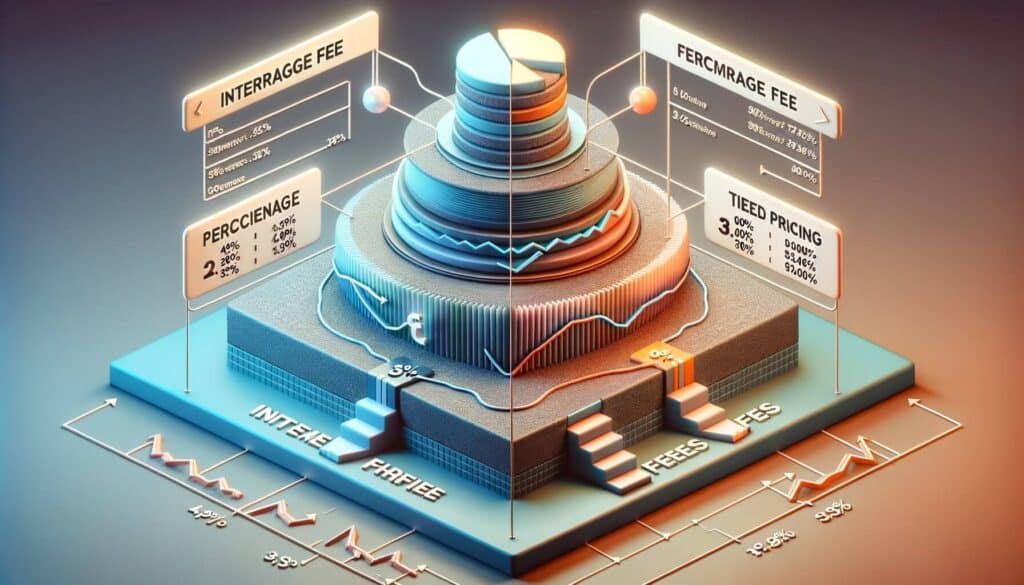
By Barbara Thomas March 11, 2025
In today’s digital age, payment processing has become an integral part of our daily lives. Whether we are purchasing groceries, booking flights, or shopping online, we rely on payment cards to complete our transactions quickly and securely. However, behind the scenes of every payment card transaction lies a complex system of fees and charges that are crucial to the functioning of the payment card industry. One such fee that plays a significant role in this system is the interchange fee.
Interchange fees are a vital component of the payment card industry, serving as a means of compensation for the various parties involved in a transaction. These fees are charged to merchants by the card-issuing banks and are intended to cover the costs associated with processing payments, managing fraud risks, and maintaining the infrastructure required for seamless transactions.
Understanding interchange-fees and how they are calculated is essential for both merchants and consumers, as they can have a significant impact on the cost of goods and services and the overall efficiency of the payment system.
What are Interchange Fees: Definition and Explanation
Interchange fees can be defined as fees charged by the card-issuing banks to the acquiring banks (the banks that facilitate the acceptance of payment cards by merchants) for each transaction made using a payment card.
These fees are typically a percentage of the transaction value or a flat fee per transaction and are set by the card networks, such as Visa, Mastercard, and American Express. The card networks act as intermediaries between the card-issuing banks and the acquiring banks, ensuring the smooth flow of funds and information between the parties involved.
The Role of Interchange Fees in the Payment Card Industry

Interchange fees play a crucial role in the payment card industry by providing a source of revenue for the card-issuing banks and incentivizing them to issue payment cards to consumers. These fees enable banks to cover the costs associated with providing payment card services, including card production, customer support, fraud prevention, and transaction processing. Without interchange-fees, banks would have little incentive to issue payment cards, leading to a decline in the availability and convenience of card-based payment options.
Furthermore, interchange fees also serve as a means of redistributing the costs and risks associated with payment card transactions among the various parties involved. By charging merchants a fee for each transaction, the card-issuing banks are able to offset the costs of providing payment card services and managing the risks associated with fraud and chargebacks. This redistribution of costs ensures that the burden of payment card processing is shared by all participants in the payment ecosystem, rather than being solely borne by the card-issuing banks.
How Interchange Fees are Calculated: Factors and Methodology

The calculation of interchange fees is a complex process that takes into account various factors and considerations. The card networks, in collaboration with the card-issuing banks, determine the interchange fee rates based on a combination of factors, including the type of card used (credit, debit, or prepaid), the merchant category code (MCC), the transaction value, and the level of risk associated with the transaction.
One of the primary factors influencing interchange-fees is the type of card used in the transaction. Credit cards, debit cards, and prepaid cards each have their own interchange fee structures, reflecting the differences in the risks and costs associated with each type of card. Credit cards, for example, typically have higher interchange fees compared to debit cards, as they carry a higher risk of default and require additional services, such as credit scoring and credit limit management.
The merchant category code (MCC) is another important factor in the calculation of interchange fees. The MCC is a four-digit code assigned to each merchant by the card networks, which categorizes the type of goods or services the merchant provides. Different MCCs are associated with different levels of risk and costs, and interchange-fees may vary depending on the MCC of the merchant. For example, merchants in high-risk industries, such as gambling or adult entertainment, may be subject to higher interchange fees due to the increased risk of fraud and chargebacks associated with these industries.
The transaction value is also taken into consideration when calculating interchange fees. In general, interchange fees are calculated as a percentage of the transaction value, meaning that larger transactions will result in higher interchange fees. This is because larger transactions typically involve higher costs and risks for the card-issuing banks, such as a higher likelihood of fraud or a greater need for customer support.
Finally, the level of risk associated with the transaction is a crucial factor in determining interchange fees. Transactions that are deemed to be higher risk, such as those involving international payments or card-not-present transactions (e.g., online or phone purchases), may attract higher interchange-fees to compensate for the increased likelihood of fraud or chargebacks. Conversely, transactions that are considered lower risk, such as those made in-person with a chip-enabled card, may have lower interchange fees.
The Different Types of Interchange Fees: Credit Cards, Debit Cards, and Prepaid Cards

Interchange fees vary depending on the type of card used in a transaction. Credit cards, debit cards, and prepaid cards each have their own interchange fee structures, reflecting the differences in the risks and costs associated with each type of card.
Credit card interchange fees are typically higher compared to debit card interchange-fees. This is because credit cards carry a higher risk of default and require additional services, such as credit scoring and credit limit management, which increase the costs for the card-issuing banks. Credit card interchange fees are usually calculated as a percentage of the transaction value, ranging from around 1% to 3% of the transaction amount.
Debit card interchange fees, on the other hand, are generally lower compared to credit card interchange fees. This is because debit cards are linked directly to the cardholder’s bank account and do not involve the extension of credit by the card-issuing banks. Debit card interchange-fees are typically calculated as a flat fee per transaction, ranging from a few cents to a few dollars, depending on the card network and the transaction value.
Prepaid card interchange fees fall somewhere in between credit card and debit card interchange fees. Prepaid cards are similar to debit cards in that they are funded by the cardholder’s own funds, but they may also carry additional risks and costs associated with managing the prepaid card program. Prepaid card interchange-fees can be either a flat fee per transaction or a percentage of the transaction value, depending on the specific terms and conditions of the prepaid card program.
Interchange Fee Structures: Flat Fees, Percentage Fees, and Tiered Pricing

Interchange fees can be structured in different ways, depending on the agreement between the card networks and the card-issuing banks. The most common interchange fee structures include flat fees, percentage fees, and tiered pricing.
Flat fees are a straightforward and transparent method of calculating interchange-fees. In this structure, a fixed fee is charged for each transaction, regardless of the transaction value or type of card used. Flat fees are often used for debit card and prepaid card transactions, as they provide a simple and predictable cost structure for both merchants and card-issuing banks.
Percentage fees are another common method of calculating interchange fees. In this structure, the interchange fee is calculated as a percentage of the transaction value. Percentage fees are typically used for credit card transactions, as they allow for a more flexible and scalable fee structure that can accommodate a wide range of transaction values.
Tiered pricing is a more complex interchange fee structure that involves categorizing transactions into different tiers based on various factors, such as the type of card used, the transaction value, and the merchant category code. Each tier is assigned a different interchange fee rate, with higher-risk or higher-value transactions attracting higher fees. Tiered pricing can provide more granularity and customization in interchange fee calculations, but it can also be more difficult to understand and compare across different payment processors.
The Impact of Interchange Fees on Merchants and Consumers
Interchange fees have a significant impact on both merchants and consumers, as they can affect the cost of goods and services and the overall efficiency of the payment system.
For merchants, interchange-fees represent a significant cost of doing business. These fees are typically passed on to the merchants by the acquiring banks, either as a separate line item on the merchant’s statement or as part of the overall processing fees. The impact of interchange fees on merchants can vary depending on factors such as the type of business, the average transaction value, and the volume of card transactions. Small businesses, in particular, may feel the burden of interchange-fees more acutely, as they often operate on thin profit margins and may not have the negotiating power to secure lower fees.
The impact of interchange fees on consumers is less direct but can still be significant. Merchants may choose to pass on the cost of interchange-fees to consumers in the form of higher prices for goods and services. This can result in increased costs for consumers, particularly for those who rely heavily on payment cards for their purchases. Additionally, interchange fees can indirectly impact consumers by influencing the availability and acceptance of payment cards. If interchange fees are too high, merchants may be reluctant to accept payment cards or may impose minimum purchase requirements, limiting the convenience and flexibility of card-based payments for consumers.
Interchange Fee Regulations and the Role of Government Bodies
Given the potential impact of interchange fees on merchants and consumers, there has been ongoing debate and regulation surrounding these fees in many countries. Government bodies and regulatory authorities have sought to strike a balance between ensuring fair and transparent pricing for merchants and promoting competition and innovation in the payment card industry.
In some countries, interchange fees have been subject to regulation or caps imposed by government bodies. These regulations aim to limit the fees charged by card networks and card-issuing banks, thereby reducing the cost burden on merchants and potentially lowering prices for consumers. However, the effectiveness of such regulations in achieving their intended goals is a subject of ongoing debate, as they can have unintended consequences, such as reduced investment in payment card infrastructure or increased fees for other payment services.
In addition to government regulations, the card networks themselves have implemented various initiatives to address concerns related to interchange fees. For example, some card networks have introduced interchange fee programs specifically tailored for small businesses, offering lower fees or simplified fee structures to support their growth and competitiveness. These initiatives aim to strike a balance between the need for interchange fees to cover the costs of payment card services and the desire to support small businesses and promote economic growth.
Frequently Asked Questions (FAQs) about Interchange Fees
Q1: What is the purpose of interchange fees?
A1: Interchange fees serve as a means of compensation for the card-issuing banks and cover the costs associated with processing payments, managing fraud risks, and maintaining the infrastructure required for seamless transactions.
Q2: Who sets interchange fees?
A2: Interchange fees are set by the card networks, such as Visa, Mastercard, and American Express, in collaboration with the card-issuing banks.
Q3: How are interchange fees calculated?
A3: Interchange fees are calculated based on factors such as the type of card used, the merchant category code, the transaction value, and the level of risk associated with the transaction.
Q4: Do interchange fees vary depending on the type of card used?
A4: Yes, interchange fees vary depending on the type of card used. Credit cards typically have higher interchange fees compared to debit cards, reflecting the higher risks and costs associated with credit card transactions.
Q5: Can interchange fees be negotiated?
A5: Interchange fees are typically non-negotiable for individual merchants, as they are set by the card networks and apply uniformly to all merchants. However, larger merchants may have more negotiating power and may be able to secure lower fees based on their transaction volume and industry.
Q6: Do interchange fees impact consumers?
A6: Yes, interchange fees can indirectly impact consumers by influencing the cost of goods and services and the availability and acceptance of payment cards.
Q7: Are interchange fees regulated?
A7: In some countries, interchange fees are subject to regulation or caps imposed by government bodies. However, the effectiveness of such regulations in achieving their intended goals is a subject of ongoing debate.
Conclusion
Interchange fees are a crucial component of the payment card industry, providing a means of compensation for the card-issuing banks and ensuring the smooth functioning of the payment system. These fees are calculated based on various factors, including the type of card used, the merchant category code, the transaction value, and the level of risk associated with the transaction.
Interchange fees can vary depending on the type of card used, with credit cards typically having higher fees compared to debit cards and prepaid cards. The impact of interchange fees on merchants and consumers can be significant, as they can affect the cost of goods and services and the availability and acceptance of payment cards.
Government bodies and regulatory authorities have sought to strike a balance between ensuring fair and transparent pricing for merchants and promoting competition and innovation in the payment card industry. While interchange fees continue to be a subject of debate and regulation, they remain an essential component of the payment card ecosystem, supporting the convenience and efficiency of card-based transactions.